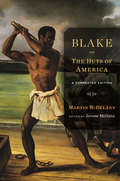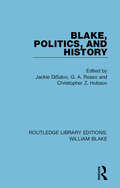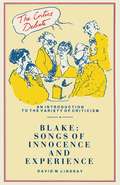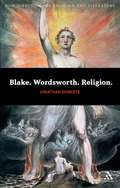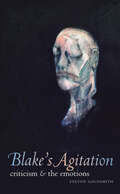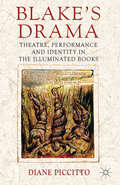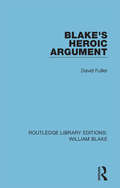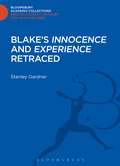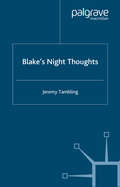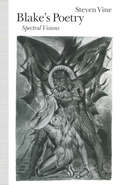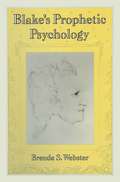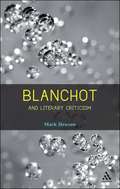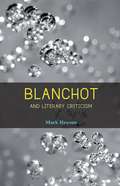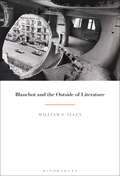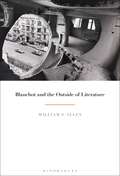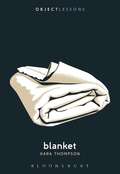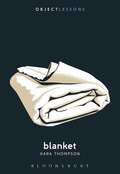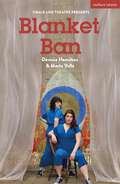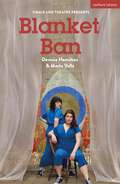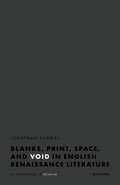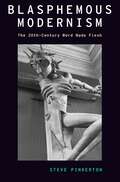- Table View
- List View
Blake; Or, The Huts of America: Or, The Huts Of America
by Martin R. DelanyMartin R. Delany’s Blake (c. 1860) tells the story of Henry Blake’s escape from a southern plantation and his travels in the U.S., Canada, Africa, and Cuba on a mission to unite blacks of the Atlantic region in the struggle for freedom. Jerome McGann’s edition offers the first correct printing of the work and an authoritative introduction.
Blake, Politics, and History (Routledge Library Editions: William Blake)
by Jackie DiSalvo G. A. Rosso Christopher Z. HobsonFirst published in 1998, this book formed part of an ongoing effort to restore politics and history to the centre of Blake studies. It adopts a three pronged approach when presenting its essays, seeking to promote a return to the political Blake; to deepen the understanding of some of the conversations articulated in Blake’s art by introducing new, historical material or new interpretations of texts; and to highlight differing perspectives on Blake’s politics among historically focused critics. The collection contains essays with varying methodological assumptions and differing positions on questions central to historicist Blake scholarship.
Blake, Politics, and History (Routledge Library Editions: William Blake #Vol. 17)
by G. A. Rosso Christopher Z. Hobson Jackie DisalvoFirst published in 1998, this book formed part of an ongoing effort to restore politics and history to the centre of Blake studies. It adopts a three pronged approach when presenting its essays, seeking to promote a return to the political Blake; to deepen the understanding of some of the conversations articulated in Blake’s art by introducing new, historical material or new interpretations of texts; and to highlight differing perspectives on Blake’s politics among historically focused critics. The collection contains essays with varying methodological assumptions and differing positions on questions central to historicist Blake scholarship.
Blake. Wordsworth. Religion. (New Directions in Religion and Literature)
by Jonathan RobertsA reassessment of Romantic religion and the structure of modern religious debate argued through the history of interpretation of Blake's and Wordsworth's religious visions.
Blake's Agitation: Criticism and the Emotions
by Steven GoldsmithBlake’s Agitation is a thorough and engaging reflection on the dynamic, forward-moving, and active nature of critical thought. Steven Goldsmith investigates the modern notion that there’s a fiery feeling in critical thought, a form of emotion that gives authentic criticism the potential to go beyond interpreting the world. By arousing this critical excitement in readers and practitioners, theoretical writing has the power to alter the course of history, even when the only evidence of its impact is the emotion it arouses. Goldsmith identifies William Blake as a paradigmatic example of a socially critical writer who is moved by enthusiasm and whose work, in turn, inspires enthusiasm in his readers. He traces the particular feeling of engaged, dynamic urgency that characterizes criticism as a mode of action in Blake’s own work, in Blake scholarship, and in recent theoretical writings that identify the heightened affect of critical thought with the potential for genuine historical change. Within each of these horizons, the critical thinker’s enthusiasm serves to substantiate his or her agency in the world, supplying immediate, embodied evidence that criticism is not one thought-form among many but an action of consequence, accessing or even enabling the conditions of new possibility necessary for historical transformation to occur. The resulting picture of the emotional agency of criticism opens up a new angle on Blake’s literary and visual legacy and offers a vivid interrogation of the practical potential of theoretical discourse.
Blake's Agitation: Criticism and the Emotions
by Steven GoldsmithBlake’s Agitation is a thorough and engaging reflection on the dynamic, forward-moving, and active nature of critical thought. Steven Goldsmith investigates the modern notion that there’s a fiery feeling in critical thought, a form of emotion that gives authentic criticism the potential to go beyond interpreting the world. By arousing this critical excitement in readers and practitioners, theoretical writing has the power to alter the course of history, even when the only evidence of its impact is the emotion it arouses. Goldsmith identifies William Blake as a paradigmatic example of a socially critical writer who is moved by enthusiasm and whose work, in turn, inspires enthusiasm in his readers. He traces the particular feeling of engaged, dynamic urgency that characterizes criticism as a mode of action in Blake’s own work, in Blake scholarship, and in recent theoretical writings that identify the heightened affect of critical thought with the potential for genuine historical change. Within each of these horizons, the critical thinker’s enthusiasm serves to substantiate his or her agency in the world, supplying immediate, embodied evidence that criticism is not one thought-form among many but an action of consequence, accessing or even enabling the conditions of new possibility necessary for historical transformation to occur. The resulting picture of the emotional agency of criticism opens up a new angle on Blake’s literary and visual legacy and offers a vivid interrogation of the practical potential of theoretical discourse.
Blake's Drama: Theatre, Performance and Identity in the Illuminated Books
by Diane PiccittoBlake's Drama challenges conventional views of William Blake's multimedia work by reinterpreting it as theatrical performance. Viewed in its dramatic contexts, this art form is shown to provoke an active spectatorship and to depict identity as paradoxically essential and constructed, revealing Blake's investments in drama, action, and the body.
Blake's Heroic Argument (Routledge Library Editions: William Blake)
by David FullerFirst published in 1988, this book is a study of all Blake’s work in illuminated printing. It traces in particular, the development of his ideas on politics, religion, sexuality, and the imagination. There are substantial sections on some of Blake’s best-known works, including the Marriage of Heaven and Hell, and the Songs of Innocence and Experience, and full critical essays on the Four Zoas and Jerusalem. The book describes the historical contexts of Blake’s work, and sets it in relation to the political controversies of his age as these are reflected in the writings of Burke, Paine and Mary Wollstonecraft. It discusses the relationships of text and design in Blake, the characteristic verbal textures and rhythms of his longer poems, some influences on his thought, and developing structure of his personal myth and its relationship to other mythologies. The opening chapter discusses areas of fundamental disagreement with some of the main approaches to Blake whilst the final chapter discusses literary theory and the practice of criticism, arguing for an open and explicit involvement of personal experience and values and a more creative use of form in critical writing.
Blake's Heroic Argument (Routledge Library Editions: William Blake #2)
by David FullerFirst published in 1988, this book is a study of all Blake’s work in illuminated printing. It traces in particular, the development of his ideas on politics, religion, sexuality, and the imagination. There are substantial sections on some of Blake’s best-known works, including the Marriage of Heaven and Hell, and the Songs of Innocence and Experience, and full critical essays on the Four Zoas and Jerusalem. The book describes the historical contexts of Blake’s work, and sets it in relation to the political controversies of his age as these are reflected in the writings of Burke, Paine and Mary Wollstonecraft. It discusses the relationships of text and design in Blake, the characteristic verbal textures and rhythms of his longer poems, some influences on his thought, and developing structure of his personal myth and its relationship to other mythologies. The opening chapter discusses areas of fundamental disagreement with some of the main approaches to Blake whilst the final chapter discusses literary theory and the practice of criticism, arguing for an open and explicit involvement of personal experience and values and a more creative use of form in critical writing.
Blake's 'Innocence' and 'Experience' Retraced (Bloomsbury Academic Collections: English Literary Criticism)
by Stanley GardnerThis major work of historical and interpretative scholarship draws upon fresh evidence to set the Songs in a new perspective. Blake's etchings are substantially discussed alongside the poems they illustrate. The plates of both Innocence and Experience are considered in detail as Blake's response to social circumstances between 1782 and 1794. The reader is asked to re-think the nature of 'the Two Contrary States', and the relationship of the designs to the understanding of Blake.
Blake's Night Thoughts
by J. TamblingBlake's Night Thoughts discusses Blake as a poet and artist of night, considering night through graveyard poetry and Young in the eighteenth-century, urbanism in the nineteenth and Levinas and Blanchot's writings in the twentieth. Taking 'night' as the breakdown of rational progressive thought and of thought based on concepts of identity, the book reads the lyric poetry, some Prophetic works, including a chapter on The Four Zoas , the illustrations to Young, and Dante, and look's at Blake's writing of madness.
Blake’s Poetry: Spectral Visions
by Steven Vine Stephen R. MandellWilliam Blake is acknowledged as a poet of opposition and contradiction: a writer who, from Songs of Innocence and Experience to his last epic Jerusalem, ceaselessly explored the conflicts between limitation and possibility, reason and energy, torment and joy. But the contradictions within Blake's own 'visionary' poetics are less often considered. Throughout his work, Blake powerfully dramatises the energies and agonies of his own poetic labour.
Blanchot and Literary Criticism
by Mark HewsonBlanchot's writings on literature have imposed themselves in the canon of modern literary theory and yet have remained a mysterious presence. This is in part due to their almost hypnotic literary style, in part due to their distinctive amalgam of a number of philosophical sources (Hegel, Heidegger, Levinas, Bataille), which, although hardly unknown in the Anglophone philosophical world, have not yet made themselves fully at home in literary theory. This book aims to make visible the coherence of Blanchot's critical project. To recognize the challenge that Blanchot represents for literary criticism, one has to see that he always has in view the self-interrogation that characterizes modern literature, both in its theory and its practice. Blanchot's essays study the forms and the paths of this research, its solutions and its impasses; and increasingly, they sketch out the philosophical and historical horizon within which its significance appears. The effect is to revise the terms in which we see the genesis of the modern literary concept, not least of the manifestations of which is literary criticism itself.
Blanchot and Literary Criticism
by Mark HewsonBlanchot's writings on literature have imposed themselves in the canon of modern literary theory and yet have remained a mysterious presence. This is in part due to their almost hypnotic literary style, in part due to their distinctive amalgam of a number of philosophical sources (Hegel, Heidegger, Levinas, Bataille), which, although hardly unknown in the Anglophone philosophical world, have not yet made themselves fully at home in literary theory. This book aims to make visible the coherence of Blanchot's critical project. To recognize the challenge that Blanchot represents for literary criticism, one has to see that he always has in view the self-interrogation that characterizes modern literature, both in its theory and its practice. Blanchot's essays study the forms and the paths of this research, its solutions and its impasses; and increasingly, they sketch out the philosophical and historical horizon within which its significance appears. The effect is to revise the terms in which we see the genesis of the modern literary concept, not least of the manifestations of which is literary criticism itself.
Blanchot and the Outside of Literature
by William S. AllenMaurice Blanchot's writings have played a critical role in the development of 20th-century French thought, but the implicit tension in this role has rarely been addressed directly. Reading Blanchot involves understanding how literature can have an effect on philosophy, to the extent of putting philosophy itself in question by exposing a different and literary mode of thought. However, as this mode is to be found most substantially in the peculiar density of his fictional writings, rather than in his theoretical or critical works, the demand on readers to grasp its implications for thought is rendered more difficult. Blanchot and the Outside of Literature provides a detailed and far-reaching explication of how Blanchot's works changed in the postwar period during which he arrived at this complex and distinctive form of writing.
Blanchot and the Outside of Literature
by William S. AllenMaurice Blanchot's writings have played a critical role in the development of 20th-century French thought, but the implicit tension in this role has rarely been addressed directly. Reading Blanchot involves understanding how literature can have an effect on philosophy, to the extent of putting philosophy itself in question by exposing a different and literary mode of thought. However, as this mode is to be found most substantially in the peculiar density of his fictional writings, rather than in his theoretical or critical works, the demand on readers to grasp its implications for thought is rendered more difficult. Blanchot and the Outside of Literature provides a detailed and far-reaching explication of how Blanchot's works changed in the postwar period during which he arrived at this complex and distinctive form of writing.
Blanket (Object Lessons)
by Kara ThompsonObject Lessons is a series of short, beautifully designed books about the hidden lives of ordinary things. We are born into blankets. They keep us alive and they cover us in death. We pull and tug on blankets to see us through the night or an illness. They shield us in mourning and witness our most intimate pleasures. Curious, fearless, vulnerable, and critical, Blanket interweaves cultural critique with memoir to cast new light on a ubiquitous object. Kara Thompson reveals blankets everywhere--film, art, geology, disasters, battlefields, resistance, home--and transforms an ordinary thing into a vibrant and vital carrier of stories and secrets, an object of inheritance and belonging, a companion to uncover. Object Lessons is published in partnership with an essay series in the The Atlantic.
Blanket (Object Lessons)
by Kara ThompsonObject Lessons is a series of short, beautifully designed books about the hidden lives of ordinary things. We are born into blankets. They keep us alive and they cover us in death. We pull and tug on blankets to see us through the night or an illness. They shield us in mourning and witness our most intimate pleasures. Curious, fearless, vulnerable, and critical, Blanket interweaves cultural critique with memoir to cast new light on a ubiquitous object. Kara Thompson reveals blankets everywhere--film, art, geology, disasters, battlefields, resistance, home--and transforms an ordinary thing into a vibrant and vital carrier of stories and secrets, an object of inheritance and belonging, a companion to uncover. Object Lessons is published in partnership with an essay series in the The Atlantic.
Blanket Ban (Modern Plays)
by Davinia Hamilton Marta VellaWinner of New Diorama, Underbelly and Methuen Drama's Untapped Award 2022Sometimes I'm afraid of this play.Malta: Catholic kitsch, golden sun, deep blue sea, Eurovision - and a blanket ban on abortion.Propelled by three years of interviews with anonymous contributors and their own lived experience, actors and activists Marta and Davinia interrogate Malta's restrictions on the freedom of women.What does it mean for your home to boast the world's most progressive LGBTQIA rights, leading transgender laws – and a population that is almost unanimously anti-choice?Blanket Ban is a rallying cry from award-winning Chalk Line Theatre. This edition was published to coincide with the production at Underbelly Cowgate, Edinburgh, in August 2022.
Blanket Ban (Modern Plays)
by Davinia Hamilton Marta VellaWinner of New Diorama, Underbelly and Methuen Drama's Untapped Award 2022Sometimes I'm afraid of this play.Malta: Catholic kitsch, golden sun, deep blue sea, Eurovision - and a blanket ban on abortion.Propelled by three years of interviews with anonymous contributors and their own lived experience, actors and activists Marta and Davinia interrogate Malta's restrictions on the freedom of women.What does it mean for your home to boast the world's most progressive LGBTQIA rights, leading transgender laws – and a population that is almost unanimously anti-choice?Blanket Ban is a rallying cry from award-winning Chalk Line Theatre. This edition was published to coincide with the production at Underbelly Cowgate, Edinburgh, in August 2022.
Blanks, Print, Space, and Void in English Renaissance Literature: An Archaeology of Absence
by Jonathan SawdayBlanks, Print, Space, and Void in English Renaissance Literature is an inquiry into the empty spaces encountered not just on the pages of printed books in c.1500-1700, but in Renaissance culture more generally. The book argues that print culture in the sixteenth and seventeenth centuries helped to foster the modern idea of the 'gap' (where words, texts, images, and ideas are constructed as missing, lost, withheld, fragmented, or perhaps never devised in the first place). It re-imagines how early modern people reacted not just to printed books and documents of many different kinds, but also how the very idea of emptiness or absence began to be fashioned in a way which still surrounds us. Jonathan Sawday leads the reader through the entire landscape of early modern print culture, discussing topics such as: space and silence; the exploration of the vacuum; the ways in which race and racial identity in early modern England were constructed by the language and technology of print; blackness and whiteness, together with lightness, darkness, and sightlessness; cartography and emptiness; the effect of typography on reading practices; the social spaces of the page; gendered surfaces; hierarchies of information; books of memory; pages constructed as waste or vacant; the genesis of blank forms and early modern bureaucracy; the political and devotional spaces of printed books; the impact of censorship; and the problem posed by texts which lack endings or conclusions. The book itself ends by dwelling on blank or empty pages as a sign of human mortality. Sawday pays close attention to the writings of many of the familiar figures in English Renaissance literary culture - Sidney, Shakespeare, Donne, Jonson, and Milton, for example - as well as introducing readers to a host of lesser-known figures. The book also discusses the work of numerous women writers from the period, including Aphra Behn, Ann Bradstreet, Margaret Cavendish, Lady Jane Gray, Lucy Hutchinson, Æmelia Lanyer, Isabella Whitney, and Lady Mary Wroth.
Blanks, Print, Space, and Void in English Renaissance Literature: An Archaeology of Absence
by Jonathan SawdayBlanks, Print, Space, and Void in English Renaissance Literature is an inquiry into the empty spaces encountered not just on the pages of printed books in c.1500-1700, but in Renaissance culture more generally. The book argues that print culture in the sixteenth and seventeenth centuries helped to foster the modern idea of the 'gap' (where words, texts, images, and ideas are constructed as missing, lost, withheld, fragmented, or perhaps never devised in the first place). It re-imagines how early modern people reacted not just to printed books and documents of many different kinds, but also how the very idea of emptiness or absence began to be fashioned in a way which still surrounds us. Jonathan Sawday leads the reader through the entire landscape of early modern print culture, discussing topics such as: space and silence; the exploration of the vacuum; the ways in which race and racial identity in early modern England were constructed by the language and technology of print; blackness and whiteness, together with lightness, darkness, and sightlessness; cartography and emptiness; the effect of typography on reading practices; the social spaces of the page; gendered surfaces; hierarchies of information; books of memory; pages constructed as waste or vacant; the genesis of blank forms and early modern bureaucracy; the political and devotional spaces of printed books; the impact of censorship; and the problem posed by texts which lack endings or conclusions. The book itself ends by dwelling on blank or empty pages as a sign of human mortality. Sawday pays close attention to the writings of many of the familiar figures in English Renaissance literary culture - Sidney, Shakespeare, Donne, Jonson, and Milton, for example - as well as introducing readers to a host of lesser-known figures. The book also discusses the work of numerous women writers from the period, including Aphra Behn, Ann Bradstreet, Margaret Cavendish, Lady Jane Gray, Lucy Hutchinson, Æmelia Lanyer, Isabella Whitney, and Lady Mary Wroth.
Blasphemous Modernism: The 20th-Century Word Made Flesh (Modernist Literature and Culture)
by Steve PinkertonScholars have long described modernism as "heretical" or "iconoclastic" in its assaults on secular traditions of form, genre, and decorum. Yet critics have paid surprisingly little attention to the related category of blasphemy--the rhetoric of religious offense--and to the specific ways this rhetoric operates in, and as, literary modernism. United by a shared commitment to "the word made flesh," writers such as James Joyce, Mina Loy, Richard Bruce Nugent, and Djuna Barnes made blasphemy a key component of their modernist practice, profaning the very scriptures and sacraments that fueled their art. In doing so they belied T. S. Eliot's verdict that the forces of secularization had rendered blasphemy obsolete in an increasingly godless century ("a world in which blasphemy is impossible"); their poems and fictions reveal how forcefully religion endured as a cultural force after the Death of God. More, their transgressions spotlight a politics of religion that has seldom engaged the attention of modernist studies. Blasphemy respects no division of church and state, and neither do the writers who wield it to profane all manner of coercive dogmas--including ecclesiastical as well as more worldly ideologies of race, class, nation, empire, gender, and sexuality. The late-century example of Salman Rushdie's The Satanic Verses affords, finally, a demonstration of how modernism persists in postwar anglophone literature and of the critical role blasphemy plays in that persistence. Blasphemous Modernism thus resonates with the broader cultural and ideological concerns that in recent years have enriched the scope of modernist scholarship.
